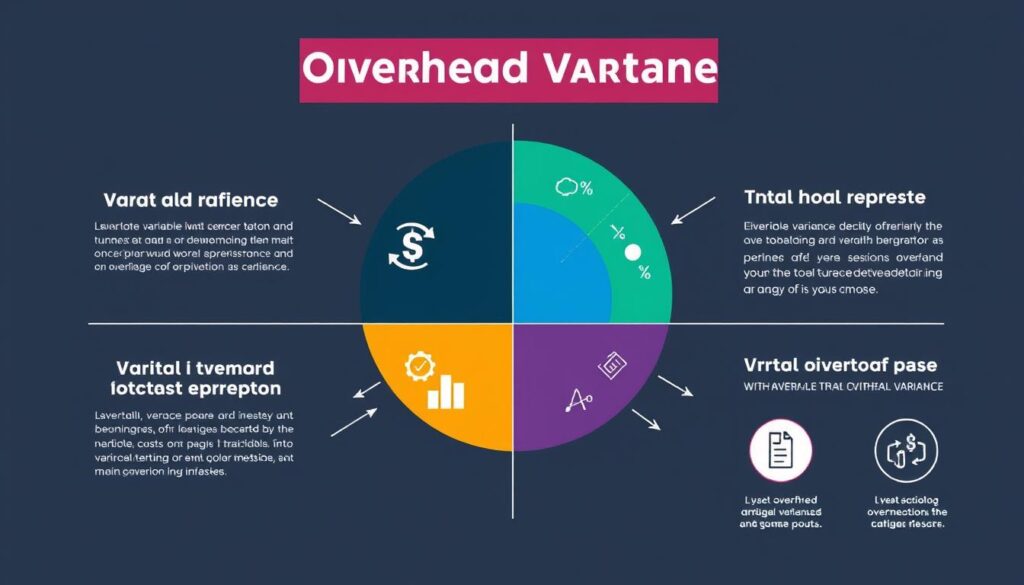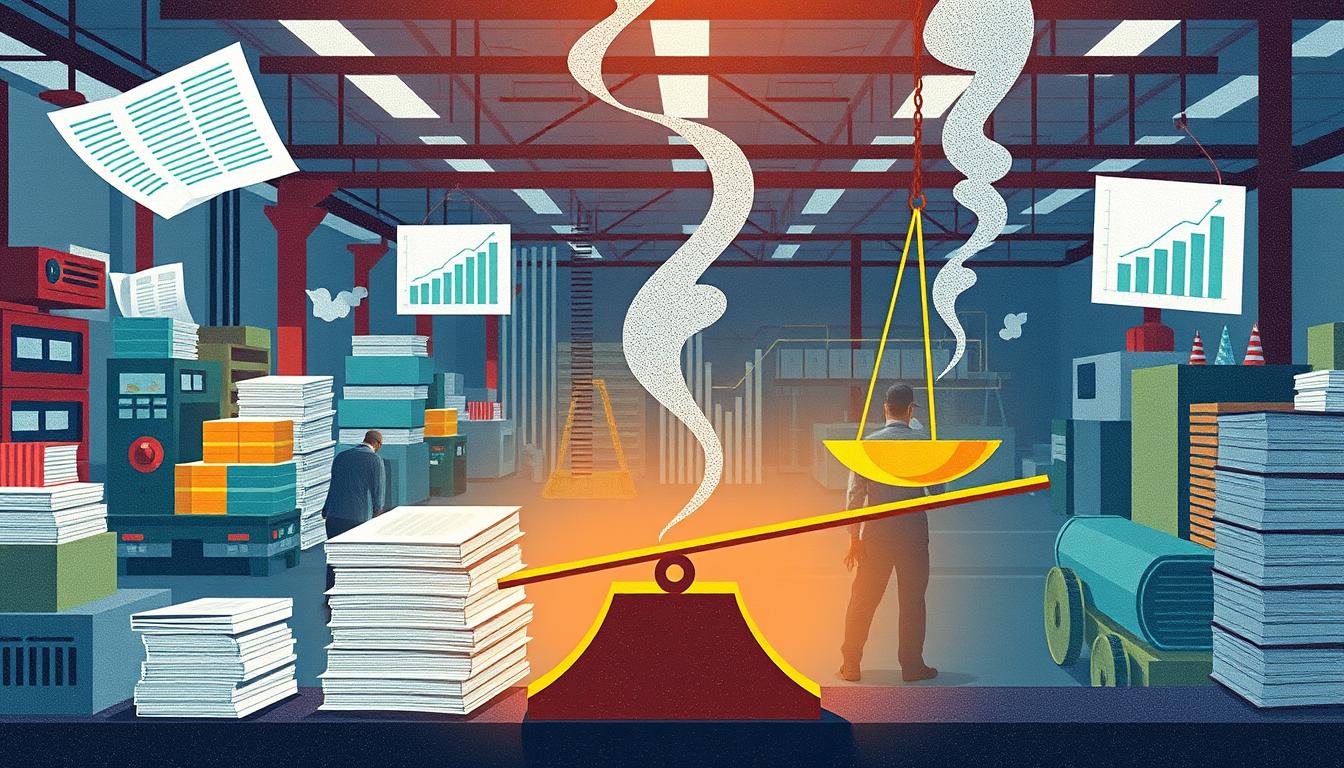Have you ever been upset because expenses unexpectedly went up? You’re not the only one. It’s hard to keep track of overhead costs, those indirect expenses that seem to disappear just when you think you’ve understood them. The total overhead variance formula is here to help. It shows the difference between your budgeted expenses and the actual numbers. This formula is a key tool for variance analysis, helping to find problems that could slow your business down. With it, you can make better budgeting choices to ensure your business thrives.
Key Takeaways
- The total overhead variance formula is crucial for comparing expected and actual expenses.
- Keeping an eye on overhead variance offers clues about financial efficiency and management.
- Different variances exist, such as budget, efficiency, and volume variance.
- Knowing these variances improves control over spending and how resources are used.
- A solid understanding of overhead costs enhances decision-making and business success.
Understanding Total Overhead Variance
Keeping overhead costs low is crucial for a strong bottom line in any business. Knowing what overhead costs are helps you see how ongoing expenses affect financial health. These costs, both fixed and variable, can change budget plans and predictions.
Definition of Overhead Costs
Overhead costs are expenses needed to run your business but not tied directly to making goods or services. These include:
- Rent and utilities
- Salaries of support staff
- Insurance
- Depreciation
Understanding overhead costs is key to figuring out profit and what resources you need.
The Importance of Monitoring Overhead Variance
Keeping an eye on overhead variance is revealing. It compares planned spending against what you actually spend. By checking these differences regularly, you can:
- Find where you’re spending too much or not enough
- Get better at managing costs
- Make smarter decisions on using resources
Let’s say your expected variable overhead costs were $40,000, but they actually were $49,200. Knowing this gap is important. It helps you fix planning mistakes. Aiming for clear finances and smooth operations helps your business stay stable and grow.
Total Overhead Variance Formula
The total overhead variance formula is key to understanding how well overhead costs are managed. It includes everything needed to get a full financial picture. This means looking at both the changing and constant costs. Another important aspect of the total overhead variance formula is the rate variance impact. This takes into account the difference between the actual and budgeted rates for overhead costs, allowing managers to see where adjustments may be necessary. By thoroughly analyzing the total overhead variance formula, organizations can gain insight into their operational efficiency and make informed decisions to improve cost management strategies.
Components of the Formula
The total overhead variance consists of important parts:
- Actual Overheads: The true costs from making products.
- Standard Overheads: The costs we expect, based on past data.
- Spending Variance: This is how actual spending compares to the budget.
- Efficiency Variance: It shows if we did more or less work than planned.

How to Apply the Formula
Here’s how to use the total overhead variance formula:
- Find out the standard and actual overhead costs.
- Work out the variable overhead spending variance with this calculation:
Actual hours worked x (Actual overhead rate – Standard overhead rate). - Look at both spending and efficiency variances to understand performance.
Using variance analysis helps see trends for better future budgeting. Keeping track of these differences improves cost strategies and decision-making. This makes businesses more profitable.
| Component | Description | Example |
|---|---|---|
| Actual Overheads | Real costs incurred during production | $100,000 |
| Standard Overheads | Expected costs based on budget | $90,000 |
| Spending Variance | Difference between actual and budgeted overheads | $10,000 over |
| Efficiency Variance | Difference between actual and budgeted activity levels | $5,000 under |
Types of Overhead Variances
Understanding the different kinds of overhead variance is key to checking a company’s financial health and how well it operates. Budget variance, efficiency variance, and volume variance are important. They tell us how an organization is doing.
Budget or Spending Variance
The budget variance shows the gap between actual costs and the planned budget over a time. It’s crucial for managing resources well. It shows how closely an organization follows its budget.
If spending is more than planned, it might mean there are inefficiencies to fix. Spending less than planned can suggest good financial management or success in saving costs.
Efficiency Variance
Efficiency variance compares actual production hours to planned hours. It’s about how well a company uses its time and resources. An unfavorable efficiency variance means needing more hours than expected. A favorable variance shows resource use was better than planned.
Volume Variance
Volume variance looks at differences between actual production and planned production. It tells us how production volume affects overhead costs. It helps check if operations match business goals. If production is more than planned, it suggests underuse of fixed overhead. Less production than planned could mean trouble meeting demand.

Formulas to Calculate Overhead Variances
Learning how to calculate overhead variances is key in managing finances well. We use many calculations to find differences between what we expect in costs and what we actually spend. Let’s look into how to calculate standard rates, figure out recovered overheads, and use the total overhead variance formula.
Standard Rates Calculation
To find the standard rate, you divide the planned overhead costs by the expected activity level. This gives us a number to compare against. For example, if a factory is running at 90% and the overhead is $9,600, the cost per unit is $5.33. If it goes up to 100%, the overhead becomes $10,000, and the cost per unit goes down to $5. With 110% capacity, the rate drops further to $4.73 per unit, with overhead at $10,400. This shows that the cost per unit changes with how much is produced.
Recovered Overheads Calculation
To figure out recovered overheads, you multiply the estimated cost per unit by how much you actually make. For instance, if you thought it would cost $5 for every unit, and you made 2,000 units, your recovered overheads would be $10,000. This way, companies can see how well they are doing at covering their costs.
Applying the Total Overhead Variance Formula
The total overhead variance formula helps in looking at the difference between real costs and what you expected to cover. By using this formula correctly, you uncover differences due to how efficiently or to what capacity you are running. If there’s a $2,000 difference in costs at full capacity, it means something’s not right. Keeping track of these numbers helps in managing your finances better.

Causes of Overhead Variance
Understanding the various causes of overhead variance is crucial for effective cost management. By identifying these specific factors, you can take proactive measures to address inefficiencies and control expenses. Here, we will explore three significant types of overhead variance: fixed overhead expenditure variance, fixed overhead volume variance, and efficiency and capacity variance.
Fixed Overhead Expenditure Variance
The fixed overhead expenditure variance happens when you spend more than planned. This might be due to unexpected repairs or maintenance costs. Recognizing these causes is key to avoiding budget overruns.
Fixed Overhead Volume Variance
This variance is about changes in production capacity with your resources. If demand shifts or interruptions happen, it could lead to higher costs per unit. Evaluating your capacity variance helps improve resource allocation.
Efficiency and Capacity Variance
These variances occur when performance doesn’t match efficiency expectations. Output lagging or operational issues can push up overhead costs. Looking into these causes offers insights for optimizing processes.
| Type of Variance | Cause | Impact on Costs |
|---|---|---|
| Expenditure Variance | Higher actual spending than budgeted | Increased costs, potential budget overruns |
| Volume Variance | Reduced production capacity | Higher per-unit costs |
| Efficiency Variance | Lower than expected output | Increased overhead costs, potential disruptions |

Conclusion
The total overhead variance formula is a key tool for understanding your company’s costs. It shows how monitoring variances can improve cost management. Knowing this formula helps identify both variable and fixed overhead variances. This helps in making strategic decisions.
Knowing the total overhead variance importance helps you see its effect on profits and how you use resources. By comparing actual and planned costs, you can find differences that show where to adjust spending. This is vital for your company’s financial health.
The key to better cost management is always checking and updating how you handle overhead. This makes your financial choices stronger and improves how things run. Aim for progress, and you’ll see benefits like lower costs and higher profits over time.









